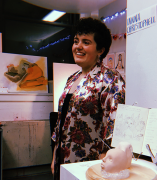
Ianna Christophell
Mixed Media Artist
Pronouns: She/Her/Hers
Email:
Related Sites:
About
I like lowbrow art.
I like the formal qualities of art that - in the contemporary, cerebral, high-art culture - now fall into the category of mass-cult.
I understand that the current demands of what art should and must be don’t allow for an artwork to exist simply as a beautiful object. Gilded filigree, complex arrangements of jewels, white chiffon draped over the curve of a woman’s hip; painstakingly-executed detail of craft. Appreciation of these types of things as the subject matter of an artwork does not quite satisfy any longer. I think with the progression that art has made through the ages, it’s a fair assessment.
I recognize the importance and great value of socially engaged art. Art has immense power, so it’s only natural that artists have come to use their creations as a means to process trauma, address social issues, and form institutional critiques. However, what is also painfully clear to me is how easily this sphere of art can become an echo chamber for negativity.
There has existed in the arts for centuries a dichotomy between art that appeals to the mind, and art that appeals to the body; the dichotomy between the cerebral or esoteric, and the physical or philistine. This is a problematic division rooted in Western dualism, and perpetuates a social hierarchy between the “educated” minority and the “uneducated” majority. It’s a method to keep power isolated to a small group of people.
Western philosophy almost exclusively dictates that bodily impulses should be suppressed or denied, as they impede true mental enlightenment. One might consider my attraction to beautiful, complexly detailed works of art that glitter and glimmer and shine as subhuman, like a magpie stealing rings and bracelets for its nest. Yet that isn’t a fair analogy. Our attraction to glimmering objects as human beings is actually a leftover biological instinct for us to seek out water; because it reminds us of the sun reflecting off its surface. I’d argue that there’s immense power in that. The very nature of mass-cult and the penchant of humans for enjoying, appreciating, and honing in on beautiful objects are precisely what make aesthetic art - in actuality - such a powerful and influential method of reaching people.
I understand that there’s something inherently outdated and tired about these modes of making. They’ve been worked clean through; nearly all of their possibilities explored.
My take on these modes, then, is an effort to bring them into the contemporary.
The shine and glitter of my sculptures draw the viewer in, but the fine detail and deep consideration I’ve given to each one are intended to prompt thought and wonder about the story behind them. She’s not just a decorated female body, she’s a character with a personality and romantic mystique. This is the woman as an entity through the lens of a woman; appreciation of woman by woman. Reclamation of the female form (and nude female form specifically) from the male gaze and male objectification as an exercise of female power. From the environment that surrounds her, to the delicate creases of her palms and fingers, each element captures the elegance, grace, and playfulness of the art of the past, but brings it into the present with my own sentiments formed by the contemporary culture I’ve grown up in.
And maybe of highest importance, gives the viewer a brief moment of lighthearted, whimsical, exuberance, to lift their mood and cleanse the palate of their spirit.